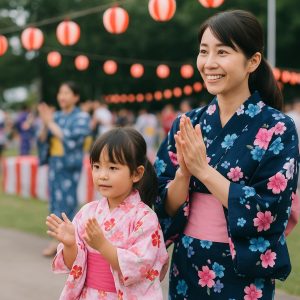The Principal’s Little Notebook|
By the Principal of Melodies international Kindergarten / Developmental
Psychologist / Mother
Nurturing “Japanese Identity” in Bangkok
Tips for Raising Children While Staying Connected to Japanese Culture
Introduction
“How can I pass on the Japanese language and culture to my child while raising them abroad?”
If you’ve ever wondered this, you’re not alone. In this article, I would like to share some ideas on how to nurture your child’s sense of
“Japanese identity” here in Bangkok.
Bangkok has a large Japanese community, with supermarkets, restaurants, and shops where Japanese food and products are easily available. In fact, it’s possible to live here while speaking almost exclusively Japanese.
However, for children to naturally develop a strong sense of being Japanese—embracing the culture, values, and spirit—it is important to make
conscious choices and small efforts in everyday family life.
5 Practical Tips
1
Enrolling Your Child in a Japanese Nursery or Kindergarten
At Japanese nurseries and kindergartens in Bangkok, classes are taught in Japanese by Japanese teachers, following the same educational guidelines as in Japan.
Nursery is provided in line with the Course of Study from Japan’s Ministry of Education and childcare guidelines, emphasizing
Japanese customs, seasonal events, and food culture.

2
Joining Community Events
The Japanese Association in Bangkok offers many opportunities for families—from prenatal classes to parent-child activities for preschoolers.
By participating in seasonal events such as Bon Odori or Mochitsuki (rice cake making), parents and children can enjoy
experiencing Japanese traditions together.

3
Exploring Japanese Language and Culture Through Picture Books
Kinokuniya in Bangkok offers a wide selection of Japanese picture books, just like in Japan. Second-hand shops are also a great place to find gently used books.
Through parent-child reading time, you can pass down not just the language, but also
values, habits, and cultural traditions in a natural way.

4
Creating a “Japanese Language Environment” at Home
While children are exposed to many languages and cultures outside the home, it is especially important to maintain a Japanese-speaking environment at home.
Spending intentional time “only in Japanese” helps preserve not just the language, but also cultural thinking patterns and values.
5
Using Media Wisely
With free platforms such as YouTube, children can easily access Japanese programs.
For younger children, programs like Shimajirō, Okaasan to Issho, and Inai Inai Baa! are widely available.
Incorporating fun Japanese-language media can be a valuable way to reinforce learning and cultural connection.
Melodies International Kindergarten (Japanese Section) & Nursery
At Melodies International Kindergarten (Japanese Section), we provide education and care based on Japanese educational principles, fully in Japanese.
Our nursery also follows the Japanese childcare guidelines, offering a Japanese-style environment.
All homeroom teachers are Japanese, and we place importance on Japanese seasonal traditions while also introducing Thai and Western cultures to nurture balanced international awareness.
Many of our graduates continue smoothly to Bangkok’s Thai-Japanese School or elementary schools in Japan, ensuring a seamless transition into the Japanese education system when returning home.
Conclusion
Keeping the heart of Japan alive, even here in Bangkok.
Together with parents, we are committed to supporting the healthy growth of every child.
Please feel free to reach out to us at any time.

